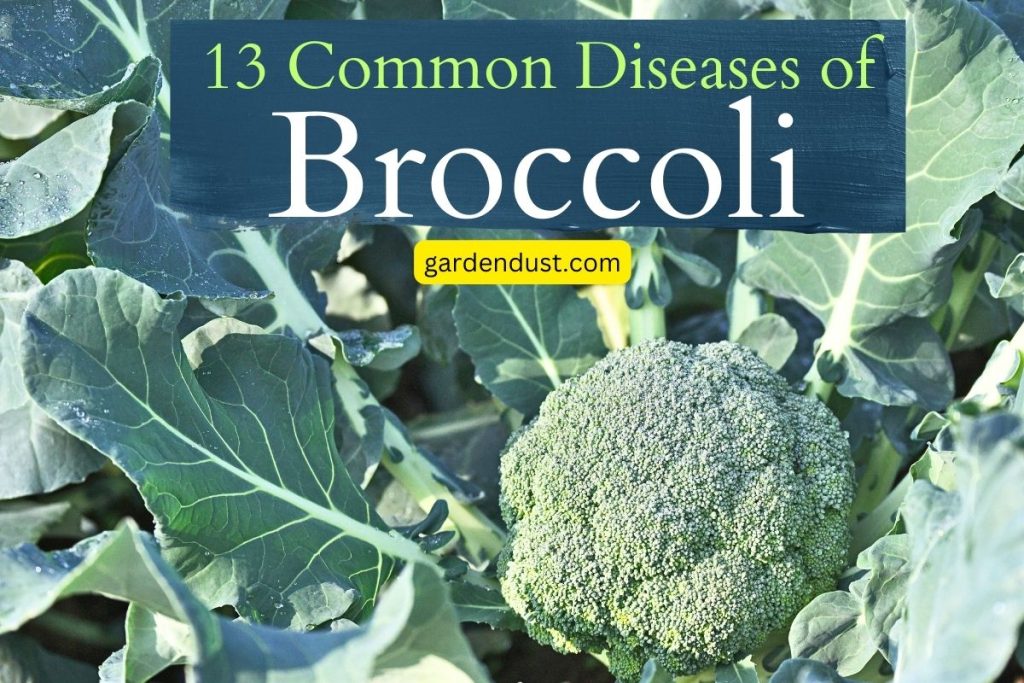Broccoli, with its dense clusters of green florets and rich nutrient profile, is a culinary and nutritional staple in many households. However, the journey from seedling to harvest is fraught with challenges as broccoli faces the threat of various diseases. Understanding these adversaries is essential for growers and enthusiasts alike to ensure a bountiful harvest and maintain the health of this cruciferous delight. In this detailed exploration, we unravel the intricacies of 13 Common Diseases of Broccoli affecting broccoli, delving into their causes, symptoms, and effective preventive measures. Let’s start….
Common Diseases of Broccoli
1.Clubroot
Clubroot, caused by the soil-borne pathogen Plasmodiophora brassicae, is a formidable adversary for broccoli. This disease induces the formation of swollen and distorted roots, resulting in stunted growth and yellowing of leaves. To combat Clubroot, practitioners of broccoli cultivation should adopt practices such as proper crop rotation, maintaining optimal soil pH, and choosing Clubroot-resistant varieties. Adequate drainage is crucial, as the pathogen thrives in waterlogged conditions. Applying lime to the soil helps manage pH levels and reduces the severity of Clubroot.
2.Blackleg
Blackleg, caused by the bacterium Xanthomonas campestris pv. campestris, manifests as dark lesions on stems and leaves, compromising the structural integrity of the plant. Employing disease-free seeds, implementing crop rotation, and utilizing copper-based fungicides in foliar applications are effective strategies to combat Blackleg. Proper disposal of infected plant material and maintaining field hygiene contribute significantly to disease prevention.
3.Downy Mildew
Downy Mildew, triggered by the pathogen Hyaloperonospora parasitica, is recognizable by yellow spots on the upper leaf surface and corresponding grayish-purple fuzz on the undersides. Preventive measures against Downy Mildew include providing ample spacing between plants to enhance air circulation, selecting broccoli varieties with inherent resistance, and timely applications of fungicides. Regular monitoring for early symptoms and prompt action contribute to effective Downy Mildew management.
4.White Rust
White Rust, caused by the fungus Albugo candida, appears as white pustules on the undersides of leaves, compromising the plant’s photosynthetic capabilities. Implementing crop rotation, maintaining proper sanitation practices, and employing fungicidal treatments are essential to prevent and manage White Rust. Additionally, selecting broccoli varieties with resistance to White Rust can provide an added layer of defense.
READ ALSO:-11 COMMON ZUCCHINI DISEASES
5.Fusarium Wilt
Fusarium Wilt, instigated by the soil-borne fungus Fusarium oxysporum, manifests as wilting, yellowing, and vascular discoloration. Adopting soil sterilization practices, selecting resistant broccoli cultivars, and managing irrigation to avoid waterlogged conditions are key strategies in combating Fusarium Wilt. Practitioners should exercise caution when introducing new plants to the field, as the fungus can be introduced through contaminated soil or plant material.
6.Powdery Mildew
Powdery Mildew, caused by various fungi, presents as a white powdery substance on leaves, hindering photosynthesis. To manage Powdery Mildew, gardeners should conduct regular inspections, ensure proper spacing between plants for adequate air circulation, and employ fungicidal treatments. Choosing broccoli varieties with resistance to Powdery Mildew adds an extra layer of protection to the crop.
7.Aphid Infestation
While not a disease in itself, aphid infestations can wreak havoc on broccoli crops. Aphids feed on plant sap, causing distorted growth and transmitting viral diseases. Introducing natural predators like ladybugs, lacewings, or parasitic wasps helps control aphid populations. Additionally, employing insecticidal soaps or neem oil provides an organic solution to manage aphid infestations.
8.Cabbage Looper
The larvae of cabbage loopers (Trichoplusia ni) can defoliate broccoli plants by voraciously feeding on leaves. Implementing biological controls, such as introducing parasitic wasps or applying Bacillus thuringiensis (Bt) insecticides, effectively manages cabbage loopers. Monitoring for early signs of infestation and timely intervention are crucial in preventing extensive damage to the broccoli crop.
9.Diamondback Moth
Diamondback Moth (Plutella xylostella) larvae pose a significant threat by feeding on broccoli leaves, leading to unsightly damage. Protective measures include the use of row covers, introducing natural predators like parasitoid wasps, and utilizing biological insecticides containing Bt. Regular monitoring for moth activity and larval presence is crucial for effective diamondback moth control.
10.Root Maggot
Root maggots, particularly those of the cabbage fly (Delia radicum), tunnel into broccoli roots, causing wilting and compromising plant health. Implementing cultural practices such as crop rotation and intercropping with repellent plants helps deter root maggot infestations. Additionally, employing beneficial nematodes or applying diatomaceous earth to the soil can be effective in managing root maggot populations.
11.Alternaria Leaf Spot
Alternaria Leaf Spot, caused by the fungus Alternaria brassicae, manifests as circular lesions with dark margins on broccoli leaves. Crop rotation, removing infected plant debris, and applying copper-based fungicides are effective in managing Alternaria Leaf Spot. Timely pruning of affected leaves and promoting good air circulation also contribute to disease prevention.
12.Rust
Rust, caused by various fungal pathogens, appears as orange-brown pustules on the undersides of leaves. Implementing proper spacing, regular pruning of affected leaves, and applying fungicides with protective action are essential in managing rust. Selecting broccoli varieties with resistance to rust can serve as a preventive measure.
13.Bacterial Soft Rot
Bacterial Soft Rot, caused by bacteria like Pectobacterium carotovorum and Erwinia spp., leads to a slimy decay of broccoli tissues. Preventive measures include practicing good field hygiene, ensuring proper drainage, and avoiding overwatering. Prompt removal and disposal of infected plant material are crucial to prevent the spread of bacterial soft rot. Using disease-free seeds and avoiding excessive nitrogen fertilization also contribute to disease management.
In the intricate dance between broccoli and its environment, understanding the nuances of these common diseases is pivotal for ensuring a robust and healthy harvest. From soil-borne pathogens to pesky insects, each adversary requires a tailored approach for effective management. By implementing preventive measures, selecting resistant varieties, and maintaining vigilant monitoring practices, growers can navigate the challenges and protect their broccoli crops. With this comprehensive guide, we aim to empower broccoli enthusiasts to cultivate this cruciferous gem with confidence, fostering a thriving and resilient harvest. Happy Gardening….







